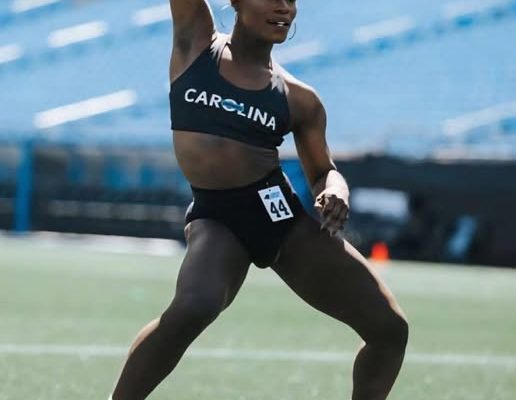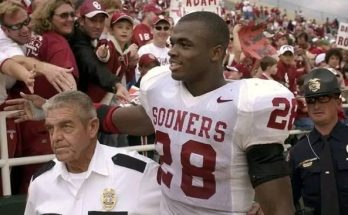The world of professional sports is often a reflection of broader society, carrying with it both the celebration of athletic excellence and the challenges of representation, inclusion, and acceptance. Among the many stories that continue to shape the modern sporting landscape, the return of Justine Lindsay to the Carolina Panthers’ TopCats squad stands out as both historically significant and deeply inspiring. Lindsay, who made headlines in 2022 when she was announced as the NFL’s first openly transgender cheerleader, has become not only a pioneering figure in professional football culture but also a symbol of courage for countless individuals across the country. Now, as news breaks that she is set to rejoin the Panthers’ cheerleading team for the upcoming season, her story continues to spark important conversations about representation in sports, the evolving culture of the NFL, and the role of trailblazers in paving pathways for others.
When Lindsay was first introduced as part of the TopCats cheer squad, the announcement resonated far beyond Charlotte, North Carolina. It was not just about one person earning a spot on a cheerleading team, but about the milestone it represented. The NFL, a league long associated with traditional gender roles, masculine performance, and historic struggles with inclusion, had its first openly transgender cheerleader on the sidelines. For Lindsay, it was about more than just dancing, performing, and representing the Panthers. It was about being authentically herself in a space where others before her may have felt they didn’t belong. For many members of the LGBTQ+ community, her breakthrough represented progress, a sign that visibility and acceptance were gradually becoming embedded in America’s most popular sport.
Lindsay’s journey to this point was not without its challenges. Entering such a highly visible role as a transgender woman in a league that has long been scrutinized for its handling of social issues required immense bravery. Beyond the physical preparation and performance demands of being part of a professional cheerleading team, Lindsay had to confront public scrutiny, online criticism, and the weight of representing an entire community. She has spoken openly in the past about the responsibility she feels to be a role model, not only for young dancers and aspiring cheerleaders but also for transgender youth who often struggle to find representation in mainstream sports and entertainment.
Cheerleading, especially at the NFL level, requires far more than athleticism and precision. Members of the TopCats are public figures who interact with fans, represent the organization in community initiatives, and embody the brand of the franchise. For Lindsay, that meant balancing the duties of her role with the visibility that came with breaking barriers. When the Panthers organization welcomed her, it also made a statement about inclusion and diversity. It was a message to fans and the league at large that football culture can be expansive enough to embrace everyone who is qualified, talented, and passionate, regardless of gender identity.
The announcement of Lindsay’s return this season is significant because it reinforces the idea that her place within the TopCats was not a one-time story or a temporary milestone. It underscores that her talent, professionalism, and contributions to the team are what earned her continued role. Returning for another year suggests that she has not only thrived within the squad but also become a valued member of the Panthers’ cheerleading family. Representation is powerful, but consistency is equally important. When a trailblazer continues to show up season after season, it normalizes their presence and solidifies the progress being made.
The Panthers themselves have been a franchise at the intersection of tradition and change. Based in Charlotte, the team operates in a region where conversations around diversity and acceptance have sometimes been met with resistance. Yet the organization’s decision to support Lindsay highlights a commitment to moving forward. The TopCats, like many NFL cheer squads, have long prided themselves on embodying athleticism, dance artistry, and community engagement. With Lindsay on the team, they also embody something else: the ability to lead cultural change within one of the most visible sports leagues in the world.
The cultural impact of Lindsay’s return extends beyond the NFL. Across professional and collegiate sports, conversations about transgender athletes and performers have become more prevalent and often polarized. Much of the national dialogue tends to focus on transgender athletes in competitive roles, particularly in women’s sports, where debates about fairness and inclusion have become hot-button political issues. Lindsay’s role as a cheerleader highlights another dimension of representation — one that is about artistry, performance, community presence, and visibility rather than competitive advantage. Her inclusion demonstrates that transgender people can and should have opportunities to participate fully in the cultural institutions of sport, whether on the field, on the sidelines, or in leadership roles.
For fans of the Panthers and the NFL, Lindsay’s return this season is also a reminder of the evolving nature of football culture. The league has long faced criticism for being slow to adapt to issues of race, gender, sexuality, and inclusion. From its delayed acceptance of openly gay players to its struggles with representation of women in coaching and executive positions, the NFL has often been accused of lagging behind other sports in terms of progress. Yet Lindsay’s presence, and her continued role on the TopCats, stands as evidence that steps are being taken. While one person’s inclusion does not erase systemic challenges, it serves as a marker that the culture is shifting, even if gradually.
What makes Lindsay’s story resonate so deeply is her authenticity. She has embraced her platform without shying away from the realities of being a public figure under constant scrutiny. In interviews, she has expressed pride in who she is and gratitude for the support she has received from her teammates and the Panthers organization. At the same time, she has not hidden from the challenges. She has acknowledged that her visibility makes her a target for criticism but insists that her focus is on the positive impact she can have. That sense of purpose — to inspire others, especially transgender youth who may feel unseen — is part of what makes her return so powerful.
Representation in sports is not only about breaking barriers but also about sustaining them. Lindsay’s second season with the TopCats ensures that the narrative of inclusion continues beyond the initial headlines. It provides a living example for the next wave of young dancers, athletes, and performers who may look at the sidelines of an NFL game and see someone who reflects their own identity. That type of visibility is invaluable, especially in a cultural climate where transgender rights and recognition are often under political and social attack. For young people navigating their identities, seeing someone like Lindsay celebrated in one of the most watched sporting events in America can be life-changing.
From a broader societal perspective, Lindsay’s journey also underscores the importance of courage in driving change. Every major step forward in representation, whether in sports, politics, entertainment, or business, begins with individuals willing to step into spaces where they have not traditionally been welcomed. Lindsay’s decision to audition, her willingness to be visible, and her commitment to representing both herself and her community all embody that spirit of courage. The fact that she will once again take her place on the sidelines, performing with joy and excellence, serves as a reminder of what can happen when authenticity meets opportunity.
Looking ahead, Lindsay’s return could inspire not only other cheerleading squads in the NFL but also professional sports teams across the country to embrace greater inclusivity. Her story shows that authenticity can coexist with tradition, that progress does not diminish excellence, and that representation can elevate the cultural meaning of sports. For the Panthers, it means another season of energy, artistry, and spirit from a squad that has always been an essential part of the game-day experience. For fans, it offers the chance to cheer not just for touchdowns and victories but for progress itself.
In the end, Justine Lindsay’s return to the TopCats is about more than just one person coming back to a cheerleading team. It is about the power of representation, the courage of trailblazers, and the capacity of sports to reflect the best of society when it chooses to embrace inclusivity. Her story is not just history-making; it is history-sustaining. Each performance, each interaction with fans, and each moment on the sidelines adds to a narrative that challenges stereotypes and reshapes cultural expectations. As she steps into another season with the Panthers, Lindsay continues to light a path forward, not only for herself but for all those who will come after her, proving once again that authenticity, talent, and courage can indeed change the game.



